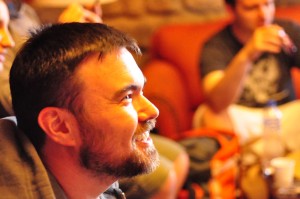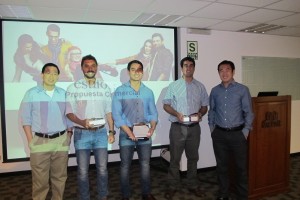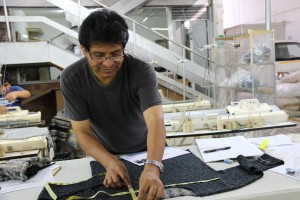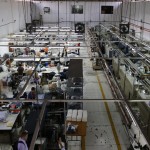Students learn about global business through travel
The Technology Management MBA (TMMBA) International Study Tour gives second year students an experience to see how people live and work in another culture. Through company visits with executives and managers and cultural excursions, it adds valuable context to learn about and understand the increasingly global economy. A few previous tours include Vietnam (2014), Dubai and Abu Dhabi (2013) and China (2012).
Students recognize how this trip relates to professional development. Viveka Raol said “Multinational companies are looking to hire leaders beyond the average MBA, instead they want leaders who have no problem working with cross-cultural teams and are able to adapt to different kinds of settings. I need to be able to fully comprehend consumer perceptions and preferences across the globe.”
From March 15-21, 2015, fifteen students traveled with faculty member Bruce Avolio and TMMBA staff to the vibrant developing country of Peru. Before departing, students studied the country and companies and set personal learning goals. They also reflected on how this trip would contribute to their development as a leader and influence future interactions with classmates.

“I was most surprised by the strongly developed and lively metropolis that is Lima. When I thought of Peru before the trip, I thought of the less-developed indigenous tribes of the highlands and jungle. I expected Peru to be a mixture of my experiences from remote areas of Mexico and India. I found Lima to be more like Spain – modern and with its own unique culture and flair for life. I was surprised to find so many foreigners in the capital city, and found the climate for business much more favorable than I had expected.” (John Koehnen)
For John Koehnen, his goal was to experience and embrace another culture and discover how life and business fit together in South America. He said “In preparation for the trip, I studied some of the recent macroeconomic trends of Peru and other countries in South America. This helped frame my expectations, understand what would be important to the people of the region, and ask better questions to uncover nuggets of information that I couldn’t get from a business journal.”
Viveka wanted to learn how the United States is perceived in Peru and practice her intercultural communication skills. She said “Simple gestures such as direct eye contact, and smiling broadly which are commonplace in the United States can be interpreted very differently in different countries and have the potential to harm business relationships.”
On our first day of company visits, we left the cool comfort of the hotel and boarded a tour bus. While the driver navigated Lima traffic, three pairs of students balanced in the aisle and presented interesting facts, figures, and stories about each company on the day’s agenda.
Our first presentation was the American Chamber of Commerce (AmCham) of Peru that promotes and fosters trade, investment, and exchange between Peru and the United States. Chief Economist Rodrigo Acha explained macroeconomic indicators, the business environment, and U.S. relations with Peru. We learned about the fading of traditional class divisions, growing middle class, and trade balances. The #1 destination for exports in 2013 was China (U.S. #2) and Peru imports more U.S. goods than other countries.

“It was great to see my classmates outside of the classroom context. Interacting during, before and after class, it is easy to see everyone only as serious and focused on studies, but the trip provided an opportunity to see the goofy and relaxed side of them.” (Phill Ramey)
“I found my classmates to be incredibly engaged and dynamic” said Phill Ramey. “They asked intelligent and informed questions that drove the collective learning forward during all of our company visits.”
We met and learned about seven more companies over the next few days.

Zhifeng Wang and Philip Xie with leaders from Ofertop.
Ofertop is a fast growing e-commerce startup who sells discounted deals. “They are a vivid illustration of TMMBA global strategy concepts and a great story of how a business can flourish by adapting to its local environment” noted Zhifeng Wang. “Unlike Groupon, Ofertop does not focus on mobile users due to low mobile penetration. Instead email is a primary channel. And since a large part of the Peruvian population still relies on cash transitions, they invented a cash payment option to make their business model feasible.”
Marga, a 50-employee textile producer and exporter, sells exquisite Alpaca knitwear. We entered the factory floor, with whirring machines and work tables, and squished into a showroom where Gonzalo Diaz, the new General Manager, explained their manufacturing steps, business markets, and expansion strategy for seven retail stores in Lima.


A student presentation started our last full day in Lima. Maureen Nash fearlessly sung these lyrics to the tune of “Come Together” by the Beatles:
Hey pay attention, Alicorp sells pasta, milk, and trades
Value to their custo-
– Mers to make them happy
Keeping business money
Founded 1956, going public 1980
Pay attention, right now, Alicorp!
Alicorp is a leading consumer goods company with 160 brands, operations in six Latin America countries, and 39% income from outside Peru. With 33 bakery brands, we were struck by their marketing strategies. They don’t market to children.
After visiting Lima, we traveled to the ancient city of Cusco, Peru, located at 11,200 feet in the Andes Mountains. Motorbikes roared through cobblestone streets while llamas grazed freely on the mountainside. We took a 2-hour drive through the rolling hills, green valleys, and jagged peaks. Another 2-hour train ride brought us to the village of Aguas Calientes, where we boarded a bus and ascended to the entrance of Macchu Pichu.
Many adjectives describe a first glimpse of looking down on the lost city of the Incas, 200 ancient stone buildings perched between four mountains. One student said “I’m speechless.”
After a group photo, we hiked for 2-3 hours to reach the Sun Gate, the official end of the Inca Trail. Viveka reflected on her experience:

“I felt a sense of humility as I connected with the ‘Pacha mama’ (mother earth) as Peruvians would call it. The vastness of the Andes Mountains and the openness of the sky reminded me that life is transient and that we need to make the most of our life journey.”
“Peruvians are selfless people who seem to put others before themselves. My most vivid memory was the long hike to the Sun Gate in Machu Picchu.
The high altitude, congested sinuses, and sleepless nights culminated in a long and treacherous hike for me. Our tour guide was patient, empathic, and encouraged me every step of the way. I can still hear his soothing voice in my head, sharing stories of the Inca and their architectural prowess. His storytelling and kind persona helped alleviate my pain and at one point he even offered to carry my bag and heavy jacket to help lighten my load.
My learning from this is to make sure that I do my very best to develop and intellectually engage my direct reports. Only if there is a pure cooperative dynamic, between employee and employer, will there be a desire to perform optimally.”
We traveled home to Seattle the next day and fondly remember the people and learning beyond the classroom walls of the Technology Management MBA program. If you’re a future or current student considering the international trip, John advises “Just go. Sign up. Explore. Take a chance. It is life-shaping and a real-life case study of all TMMBA learnings to-date.”
Photos courtesy of Paul Jeyasingh.
